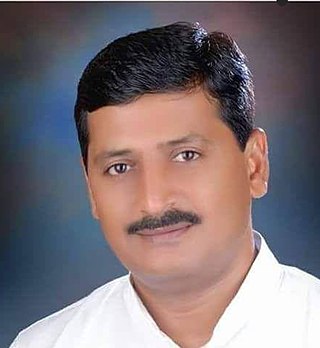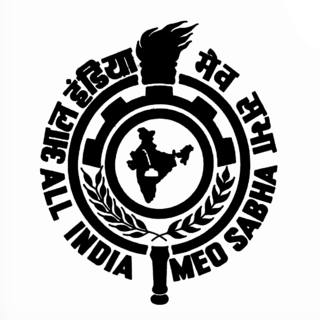The Meo are an ethnic group from the Mewat region of north-western India.

Gurgaon district, officially known as Gurugram district, is one of the 22 districts of Haryana in northern India. The city of Gurgaon is the administrative headquarters of the district. The population is 1,514,432. It is one of the southern districts of Haryana. On its north, it is bounded by the district of Jhajjar and the Union Territory of Delhi. Faridabad district lies to its east. To its south lie the districts of Palwal and Nuh. To the west lies Rewari district.

Mewati is an Indo-Aryan language spoken predominantly by the Meo people. It has three million speakers in the Mewat Region. While other people groups in the region also speak the Mewati language, it is one of the defining characteristics of the Meo culture.

Nuh district is one of the 22 districts in the Indian state of Haryana. The district is known for having the largest Muslim population in Haryana.
Ferozepur Jhirka is a town in the Nuh district of the Indian state of Haryana. It was founded by the ruler of Mewat State, Khanzada Feroz Khan.

Nuh(Hindi/Urdu pronunciation: [nũːɦ]) is a city in the Indian state of Haryana. It is the administrative headquarter of the Nuh sub-division in Nuh district of Haryana and lies within in the National Capital Region of India.
Sohna is a town and a municipal council in the Gurugram district of Haryana, India. A popular tourist weekend and conference retreat, it is on the highway from Gurugram to Alwar near a vertical rock. Sohna is known for its hot springs and Shiva temple. Sohna tehsil is part of Ahirwal Region. Major communities in Sohna are Rajputs, Ahirs, Gujars, Jats, and Muslim Gujjar. Gurugram district is divided into 4 sub-divisions each headed by a Sub-Divisional Magistrate (SDM): Gurugram, Sohna, Pataudi and Badshahpur.

Haryana, formed on 1 November 1966, is a state in North India. For the administrative purpose, Haryana is divided into 6 revenue divisions which are further divided into 22 districts. For Law and Order maintenance, it is divided into 5 Police Ranges and 4 Police Commissionerates.
Gandhi Gram Ghasera or Ghasera is a village in Nuh district of Haryana state in northern India. It is dominated by Meos. Gandhi was added to its name after it was visited by Mahatma Gandhi who asked the predominantly Muslim Meos to not migrate to Pakistan.
Ujina is a Village located in Hodal-Nuh road in Nuh district in Haryana. In Ancient time, Ujina was popular with the name of Ujina Lake as in rainy season it totally covered with water and people of nearby territories often came here for sightseeing. Ujina has 100% Hindu population. The People of Ujina actively participated in every war of Independence of India, whether it was the 1857 war; The First war of Independence or the Satyagrah by Mahatma Gandhi.
Ghasera Fort is a ruined fort in Ghasera village in Nuh district of Haryana state in northern India, which has been notified as a protected monument by the state government. Currently, the majority of the residents of the village are Muslim Meos, though Hindus also live there.
Raja Bahadur Nahar Khan was the ruler of Mewat and the progenitor of Khanzada Rajput clan who were themselves a sub-clan of Jadaun Rajputs. His original name was Sambhar Pal and later came to be known as Nahar Singh. He and his brother Sopar Pal embraced Islam under the influence of Firuz Shah Tughlaq after he annexed their estates. He was also known as Wali-e-Mewat Raja Bahadur Nahar Khan
The Mewat State was a sovereign kingdom ruled by the Khanzadas of Mewat. They were a ruling dynasty of Muslim Rajputs from Rajputana who had their capital at Alwar. The Khanzadas were Muslim Rajputs who descended from Raja Sonpar Pal who was a Rajput who converted to Islam during the period of the Delhi Sultanate in India.
The Delhi–Mumbai Expressway is a 1,350 km long, 8-lane wide under-construction access-controlled expressway connecting India's national capital New Delhi to its financial capital Mumbai. The foundation stone for the project was laid by union minister Nitin Gadkari in the presence of Sushma Swaraj and Arun Jaitley on 8 March 2019 and is inaugurated by PM Modi. The total project value including the land acquisition cost is around ₹1,00,000 crores .
Bhadas is a village, near Nuh city in Nuh district of Haryana state of India. It lies in the Mewat region of Delhi NCR and Delhi–Mumbai Industrial Corridor. It is located on the MDR135 to Hathin–Palwal and is also adjacent to the Delhi–Mumbai Expressway. It is 20 km from the Ferozepur Jhirka subdivision and 20 km from the Nuh city, district headquarter, 100 km far from national capital New Delhi and 355 km from state capital Chandigarh. It falls on the southern border of Haryana, near Alwar and Bharatpur Districts of Rajasthan. This lies in one of the most backward areas of the nation.

Er. Mamman Khan is an Indian politician from the Indian National Congress, who was elected as a member of the Haryana Legislative Assembly representing the Ferozepur Jhirka constituency in the Nuh district of Haryana.
The 2023 Haryana riots commonly referred to as the Nuh violence were a series of clashes in northern India that originated in the state of Haryana and have subsequently spread to nearby regions. On 31 July 2023, communal violence erupted in the Nuh district of Haryana between Muslims and Hindus during an annual Brajmandal Yatra pilgrimage organised by the Vishva Hindu Parishad (VHP). By the evening of the same day, fresh incidents of communal violence were reported from Gurugram and Sohna. As of 3 August 2023, the situation had resulted in at least seven fatalities and over 200 reported injuries.

Chaudhary Rahim Khan or Shri Rahim Khan was an Indian politician, who served as a Member of Parliament representing the Faridabad constituency in the Lok Sabha, the lower house of the Indian Parliament. He died before he was to complete his term as Member of Parliament. He was also elected as a Member of the Haryana Legislative Assembly three times and served as the Minister of Power and Irrigation, Waqf, and Fisheries in the Government of Haryana.

The All India Meo Sabha is an Indian political organisation and advocacy group based primarily in the Mewat region of India. It was formed under the leadership of Chaudhary Rahim Khan in 1967.
Chaudhary Mohammad Yasin Khan was an Indian politician, social reformer and a prominent leader in the Mewat region of India.








